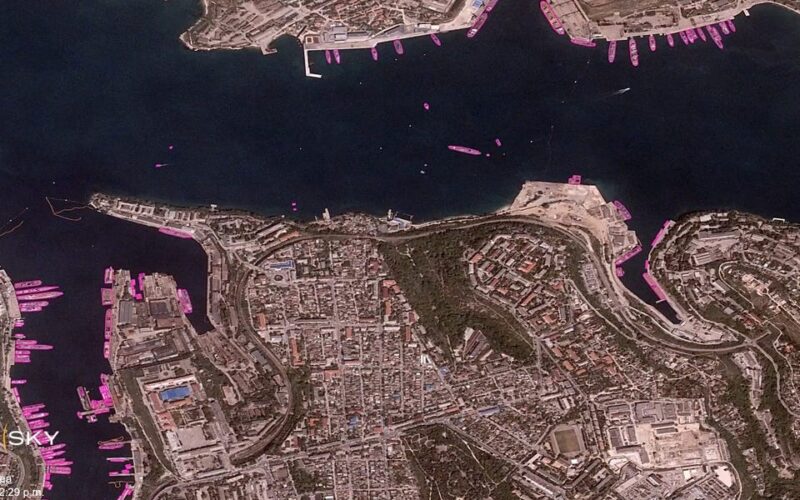Armed with exploding naval drones and long-range missiles, Ukraine has managed to push Russia’s Black Sea Fleet away from its long-held headquarters in the occupied Crimean peninsula to other bases far away.
A series of high-profile Ukrainian attacks on the port of Sevastopol and Russian warships last year trigged the withdrawal of Russian warships to bases in the port cities of Feodosia, on the other side of Crimea, and Novorossiysk, in Russia, as Moscow sought better protection for its naval assets.
Newly released satellite imagery captured by BlackSky, a real-time, space-based intelligence company, and obtained by Business Insider reveals the dispersal of the Black Sea Fleet — one of Ukraine’s defining successes of the war. Kyiv, lacking a proper navy of its own, has inflicted shocking losses on Russian warships and, in the process, opened up a crucial maritime corridor to help support its economy.
Ukraine has relied on its fleet of homemade naval drones and missiles to sink, destroy, or damage at least 24 Russian vessels in the Black Sea, US Defense Secretary Lloyd Austin said last week.
These attacks span the entirety of the war, but the exodus of the Black Sea Fleet didn’t really kick into gear until September 2023. That month, Ukraine carried out two separate attacks on Sevastopol using Western-made cruise missiles to bombard a key shipyard and the fleet’s headquarters.
BlackSky
The British defense ministry noted in October that the increasing threats to Sevastopol — as evidenced by the earlier strikes on the shipyard and headquarters — were likely forcing Moscow to disperse its naval operations across the Black Sea and away from Crimea’s battered western coast.
BlackSky said it generated tens of thousands of automated detections of military vessels between January 2022 and April 2024, giving it insight into the scale of the Russian withdrawal.
In the months after the Sevastopol strikes, BlackSky found that there was an 18% drop in detections in the port.
Meanwhile, it recorded a 23% increase in detections in Feodosia and a 22% increase in detections in Novorossiysk — just shy of 100 miles and just over 200 miles away from Sevastopol, respectively. These figures underscore a noteworthy departure away from western Crimea to other locations that may be harder for Ukrainian missiles and drones to reach.
BlackSky
A series of satellite images captured in the months before and after the damaging Sevastopol strikes further highlights the Black Sea Fleet’s dwindling presence at the city’s port, as warships were distributed across the region to Feodosia and Novorossiysk.
BlackSky
BlackSky
BlackSky
BlackSky
BlackSky also said it observed an increase in apparent maritime security measures at the entrances to the ports where Russian vessels were docked, including at Sevastopol despite the decrease in naval activity there. Western intelligence and analysts have identified these defenses as netting, floating booms, and moored barges.
BlackSky
With a diminished presence of Russian warships around Sevastopol and Crimea’s western coast, Ukraine in recent weeks has resorted to attacks on smaller vessels like patrol vessels and tugboats in a bid to continue inflicting naval losses on Moscow.
The Black Sea fight has been a bright spot for Ukraine amid the slow-moving campaign on the ground. Russia has been unable to consistently defend against this innovative and asymmetrical style of warfare, and officials in Kyiv have vowed to press on with this highly effective campaign of missile and naval drone attacks.
A general in the Security Service of Ukraine, which has carried out naval drone attacks on Russian warships and infrastructure, previously told BI that Kyiv is not only driving Moscow’s naval assets away, but it is also destroying them in the process — highlighting some of the strategic benefits of the campaign.
“We managed to unblock the grain corridor and suppress the activity of Russian missile launchers firing from the sea at the territory of Ukraine,” said Brig. Gen. Ivan Lukashevych. “Forcing the enemy to flee from the Black Sea was the goal we sought,” he added, “and it was achieved.”
Source link
lol

